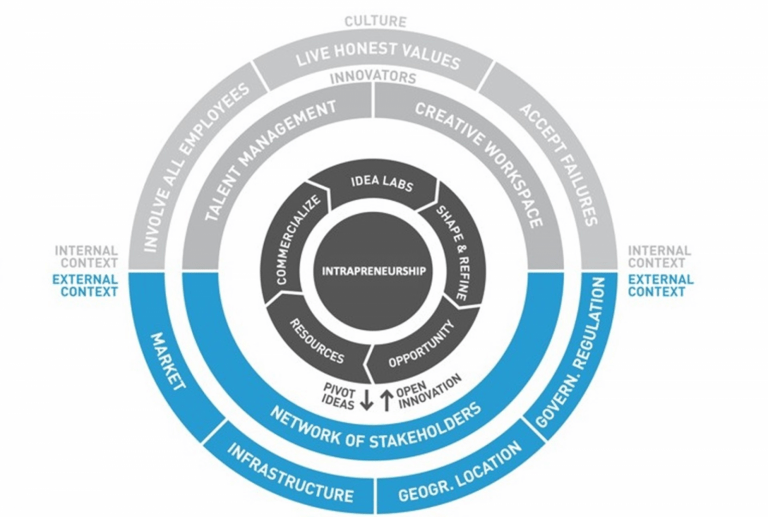“Dreamers who do” — Gifford Pinchot III (who coined the term ‘intrapreneur’ in 1978)
The digital revolution has and will continue to change the way we live and work. As we enter into Industry 4.0, the business environment is turning increasingly volatile, uncertain, complex and ambiguous (collectively known as VUCA). With new innovations and novel business models popping up in the market, existing industries face a high risk of becoming irrelevant. To counter this issue, companies have since been looking to push their employees to take ownership of their responsibilities to create and innovate. This is termed as intrapreneurship.
What is intrapreneurship?
Intrapreneurship is about empowering the employees within the organisation by encouraging them to think, dream and act like entrepreneurs. These employees are competitive and passionate, and are motivated in pursuing innovation. They are willing to take calculated risks to grow the company while the company will provide the support and resources needed for them to make their ideas a reality.
Intrapreneurship vs Entrepreneurship
Both intrapreneurs and entrepreneurs have similar qualities and traits. They are known to be passionate, resilient, confident and am able to see things from a bird’s eye view. With all these qualities, they are often rewarded with positive results for their hard work and effort made. These rewards include monetary incentives, authority, learning experiences, networks, and also the opportunity to create.
So, one may question, what are the differences between the two? The main difference is that an entrepreneur usually starts and leads his own company while an intrapreneur works for an organisation. This allows intrapreneurs to create and innovate without much of the risks faced by entrepreneurs – bankruptcy, huge failure, major debts etc.
How does intrapreneurship benefit companies?
Intrapreneurs could put their high adaptability skills to use by coming up with creative ways to solve problems, without taking on any personal risk. They would be acknowledged by their company and be rewarded handsomely if they succeed. The company could also benefit from these new innovations in terms of tangible profits, or even intangible image and reputation. Even if the innovation does not produce much positive results, companies could take this opportunity to revise their strategies, taking into account the failures to create a better product, service or business models to serve their needs. This brings a win-win situation for both the company and the individual.
With intrapreneurs in your leadership team, there can be novel ways in the treatment of specific key performance indexes and business units. These ways could become ever more effective in pushing the employees to do better with renewed criteria, rewards and incentives.
To further elaborate, we can look at the example of Ferrovial. The company mainly develops, operates and maintains sustainable infrastructures. They are involved in construction, environmental services, airports and more.

Their Human Resource (HR) function faced a challenge in which they needed to retain talent and also conceptualise new business ideas. With this, the company decided that the HR could tap on the concept of intrapreneurship. They created a 4-month Innovation Program named ShuttleX, which collected challenges that various business units face. Thereafter, they invited employees to solve these challenges. The ultimate aim was to create new business models for the company in a systematic manner.
There were a total of 4 teams which embarked on this program. They started with ideation and validated it through prototypes. After presenting their proposals to the management team, only 2 out of the 4 proposals were selected for the pilot programs. Participants came out of the program with new learning experiences and were acknowledged for their ideas and hard work.
This example shows that, with intrapreneurship, companies can look forward to having new business models that could be an excellent and powerful method to move the business forward. This could become part of the company’s strategy to expect the unexpected, anticipate change and embrace ambiguity in today’s Industrial Revolution 4.0.
How should we instill the sense of intrapreneurship in our team?
A research by a group of professors from Harvard have discovered that organisations would need to adopt a holistic approach in order to develop and create revolutionary innovations. They conducted more than 600 interviews at Fortune 100 companies, such as PepsiCo, Corning and more. Their research findings revealed that organisations generally require 8 elements, namely:
1. Commitment from the leadership and the innovation culture
2. System-wide resources
3. Administration that is able to deliver
4. Extent of revolutionary innovation
5. Inclusive organisational structure
6. Procedures and tools
7. Criterias and incentives for employees’ innovations
8. Unique skills and talents
These elements can take shape in various ways, but they boil down to creating a system that includes innovation as part of the organisational culture and tradition. For a simpler and more concise view on implementing and embracing intrapreneurship, we can consolidate the essence of these 8 elements into 3 factors:
1. Be transparent and clear of the company’s core values and vision
2. Embrace a culture that does not condemn failures
3. Encourage employees to dream and act on their dreams
Factor 1: Be transparent and clear of the company’s core values and vision
The leadership team should be clear about the company’s core values and vision in terms of innovation. This is to understand what kind of innovation the company is looking out for and also what kind of innovation is suited and needed by the company. The company could then focus on these aspects and provide support and resources for certain kinds of innovation more than others. Furthermore, the organisation should share these goals and aims with their employees and be receptive of any feedback from them. This would indirectly make the employees feel inclusive and hence be more proactive in suggesting ideas and innovations. With a clear-cut goal and proactive employees, the leadership team can then move and push the company forward to achieve their goals and objectives.
Factor 2: Embrace a culture that does not condemn failures
A large part of intrapreneurship is about realising ideas and dreams. With that in mind, it is difficult to not have failures. We would need to learn to understand failures and learn from mistakes, rather than condemn failures. Organisations should start with providing a safe haven where employees are motivated and proactive in realising their dreams. Even if failures do happen, they would not be set-back with negative sentiments or critiques from other people, but rather bounce back up with support and encouragement.
The post-it-noted by 3M is an example of an idea borne from intrapreneurship. At one point in time, 3M was looking to develop a special adhesive product to launch in the market, but the project did not garner much positive results. However, instead of condemning the failure of this product, the company continued to motivate its employees. A 3M engineer then saw potential in using this adhesive for another project, and from there, he came up with the revolutionary invention – the 3M post-it-notes.
3M was one of the first few multi-national corporations to encourage creativity amongst their employees. They allowed their employees to spend up to 15% of their working hours to take up new projects and pursue their innovations. This unique company culture eventually led to a continual success for 3M.
From the above example, it can be seen that with such an environment, more game-changing innovations can then take place as employees would be more daring to dream and dream big. This also explains why employee value is becoming increasingly more important.
Factor 3: Encourage employees to dream and act on their dreams
Organisational adaptation is never easy, having to facilitate the switch in mindset of all its employees. Organisations should never suppress the creativity of employees. This is evident in the case of Kodak. Kodak used to enjoy the reputation as one of the top selling brands of film cameras in the past. At the peak of their business, Steven J. Sasson, an electrical engineer working at Kodak actually invented the first digital camera. However, Kodak’s management team grew skeptical about his invention as it was filmless photography. Eventually, his invention and his prototype were rejected by Kodak’s management. Being critical of new inventions, their reluctance to adapt and accept innovation eventually led to their downfall and they filed for bankruptcy in 2012. They missed this massive opportunity to pioneer the creation of digital cameras as they were not ready to compete in the emerging market of digital technology at that time. Of course, all these have now passed, and Kodak had now bounced back with new advanced technologies in their wide array of digital products.
In view of this, organisations should learn to be accepting of new ideas and innovations, and to also understand the need to support the employees’ creativity. Providing emotional and mental support for employees is necessary. In addition, physical support is also helpful in this phase of transition. In view of this, organisations can start by helping the employees embark on their journey by providing them a certain guideline in their pursuit of innovation and creation.
With this in mind, organisations can adopt the Minimum Viable Product (MVP) technique to test their employees’ business ideas and products with real users. Building a MVP would help the employees to determine where the market would be receptive to their business idea or product. As they test their MVP out, they can slowly evolve it to obtain product-market fit, making it less likely to fail when first launched officially into the market.
This could help facilitate the employees to get accustomed to the notion of transforming ideas into reality.

Source: IMD
In summary, the key takeways are as follows:
1. Intrapreneurship is necessary in this day and age
2. Understand how intrapreneurship can benefit your company
3. Adopt a holistic approach in organisational adaptation – be clear of your organisation’s core values and vision to align your innovations against
4. Appoint a team to establish this new culture
5. Be mindful of both emotional and physical acceptance of the new culture and provide support to the employees in both ways
Every individual has the potential to become more than what they can, it just depends on whether you can harness this potential of them and develop them into more than what is expected. As quoted from Pinchot, we should believe that every individual can become ‘dreamers who do’.
About the author
Chin Yan Bing is a first-year student studying Business at Nanyang Technological University.
Do check out Intranpreneurialism Course on LearnGlobal.
With references to:
- Corbett, A. (2018, June 26). The Myth of the Intrapreneur. Retrieved May 22, 2020, from https://hbr.org/2018/06/the-myth-of-the-intrapreneur
- Deutsch, C. H. (2008, May 2). At Kodak, Some Old Things Are New Again. Retrieved May 28, 2020, from https://www.nytimes.com/2008/05/02/technology/02kodak.html
- Innov8rs Team. (2018, July 27). 3 Companies Who Are Doing Intrapreneurship Right. Retrieved May 24, 2020, from https://innov8rs.co/news/3-companies-who-are-doing-intrapreneurship-right/
- Trenchard, R. (2016, May 11). Be inspired: Five brilliant examples of intrapreneurship in action. Retrieved May 28, 2020, from https://www.virgin.com/entrepreneur/be-inspired-five-brilliant-examples-intrapreneurship-action
- Vogel, P., Kurak, M., & McTeague, L. (2018, July). Building an intrapreneurial organization. Retrieved May 22, 2020, from https://www.imd.org/research-knowledge/articles/Building-an-intrapreneurial-organization/



